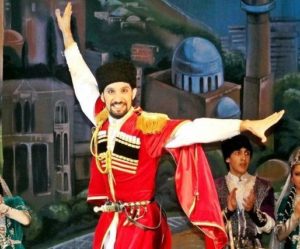 Each ethno-social group has its own customs, traditions, way of life, and worldview. Clothing plays a special role.
Each ethno-social group has its own customs, traditions, way of life, and worldview. Clothing plays a special role.
It is recognizable, practical, warm in winter and comfortable in summer. But what do we know about the different types of dads?
The article will discuss the traditional Cossack headdress - papakha (photo).
History and definition of papakha
A papakha is a headdress made of sheepskin, astrakhan fur. Its occurrence is associated with an element of the military uniform of the peoples of the Caucasus.
 Men's headwear is present in the wardrobe of peoples of Turkic roots.
Men's headwear is present in the wardrobe of peoples of Turkic roots.
It has been worn in the Russian army since 1881 by order of the military departments:
- in the Cossack troops;
- in the convoy of Alexander I;
- steppe troops in the Urals, Transbaikalia;
- Caucasian troops of Dagestan and Ossetia;
- equestrian division of Turkmenistan;
- Siberian troops.
In 1992, the papakha as a headdress for military personnel was abolished. She was reintroduced into the army only in 2005. Generals and colonels of the Armed Forces of the Russian Federation have the right to wear a hat.
Until 1812, headdresses were made from the skins of bears, rams, and wolves.The man showed his hunting abilities. And the hats were distinguished by increased strength and the ability to smooth out a blow from a saber.
Hats for the main entrance were trimmed with silver braid, 1–2 centimeters wide.
 At the beginning of the twentieth century. Don, Astrakhan, Orenburg, Siberian, Semirechensk Cossacks wore only gray headdresses. During the wars they were replaced by blacks. Hats were sewn cone-shaped with short fur. Bright colors were prohibited.
At the beginning of the twentieth century. Don, Astrakhan, Orenburg, Siberian, Semirechensk Cossacks wore only gray headdresses. During the wars they were replaced by blacks. Hats were sewn cone-shaped with short fur. Bright colors were prohibited.
Each man had three hats: for weddings, everyday wear and mourning.
Types of hats
 Types of hats differ in the height of the fur, material, and embroidery of the bottom.
Types of hats differ in the height of the fur, material, and embroidery of the bottom.
They were named by name and depending on the territorial affiliation of the peoples: Papagi, Trukhmen, Kabardians.
Reference! The top part of the headdress is called the bottom.
Kubanka, klobuk and trukhmenka
Let's look at what different types of daddies look like:
Kubanka comes from the Cossacks of Kuban. It is low, made from the skins of astrakhan fur, smushka (skins of lamb up to three days old), and whiting (skins of 14-30 day old lambs). The bottom of the hat is colored, made of cloth or genuine leather.
Reference! In the northern regions, wolf skins were popular as a material. They were not worn for hunting: the wolf smell scared off prey.
Two stripes at the top in the shape of a cross hide the seams: the hat is sewn from four parts. This patch is called galun.
 The color of the top determines the location of the military service:
The color of the top determines the location of the military service:
- blue among the Terek Cossacks;
- red - among the Don;
- yellow - among Astrakhan residents.
Important! Only a person with high moral values can receive a Kubanka.
In Rus' until the 19th century. they called papakha hoods. It was made from lamb skins and the top was trimmed with cloth. During the Caucasian Wars, the word “papakha” was borrowed.
Trukhmenka it was called the Don troops in the 16th - 18th centuries. There were no Astrakhan lambs on the Don. Therefore, such a headdress was a rarity and a valuable battle trophy.
 It was worn by atamans, Cossacks with good financial income. They made hats from skins with long fur.
It was worn by atamans, Cossacks with good financial income. They made hats from skins with long fur.
Reference! The ataman's hat was gray with a red cuff. It was sewn from sheep meat.
The shape changed depending on fashion. Kabarbinki with an expanded or kubanka with a flat top appeared.
Papakha with a cuff
The proverb “to give blows” comes from the appearance of this hat. A cuff is a sewn-on cap in the shape of a wedge.
 Metal plates were placed in it to protect itself during battle.
Metal plates were placed in it to protect itself during battle.
Reference! A disarmed warrior could fight with his hat and cuffs.
From astrakhan
For Caucasians, a hat is a source of pride. It is removed in a special case - a request for forgiveness of blood feud. It is strictly forbidden to be without a headdress during other calls.
 The headdress is designed to instill pride and character in the owner, and to develop the habit of keeping his back straight.
The headdress is designed to instill pride and character in the owner, and to develop the habit of keeping his back straight.
The hat also has its own traditions. A shy young man can ask a girl to marry him by throwing his hat out the window. If the hat is not returned for a long time, the offer is accepted.
 Craftsmen sewed headdresses from the skins of young Astrakhan lambs. The most valuable skin was removed from lambs 1-3 days old. The fur was shiny and had a distinct pattern. These hats were intended for the highest military ranks - generals. Curls lined up in a row are a sign of high quality.
Craftsmen sewed headdresses from the skins of young Astrakhan lambs. The most valuable skin was removed from lambs 1-3 days old. The fur was shiny and had a distinct pattern. These hats were intended for the highest military ranks - generals. Curls lined up in a row are a sign of high quality.
Several additional views
Kabardinka – differs in height. It is suitable for the warm season. It is a hat made of cloth with a narrow fur trim. The top is decorated with golden braid and a button in the middle.
 Papakha "crow's nest" has black color and high fur.
Papakha "crow's nest" has black color and high fur.
The return of the hat after the revolution
The revolution of 1917 was marked not only by a revolution in power, but also by a change in national dress. The Cossacks were forbidden to wear their usual hats, replacing them with budenovkas.
 Troops received permission to wear traditional headdress in 1936. The hats were black, low with cross-shaped stripes. Officers had golden stripes, and privates had black stripes. The front of the cap was decorated with the army sign - a red star. Four years later, the papakha was made the headdress of senior officers, and after the death of V. G. Stalin, it was customary for members of the Politburo to wear it.
Troops received permission to wear traditional headdress in 1936. The hats were black, low with cross-shaped stripes. Officers had golden stripes, and privates had black stripes. The front of the cap was decorated with the army sign - a red star. Four years later, the papakha was made the headdress of senior officers, and after the death of V. G. Stalin, it was customary for members of the Politburo to wear it.
For a Cossack, a papakha is a symbol of pride. There are many beliefs and customs associated with it. It was only possible to lose it in case of death. Now traditions are a thing of the past. The headdress is worn for services and holidays, but reverent attitude and respect remain.


 1
1





